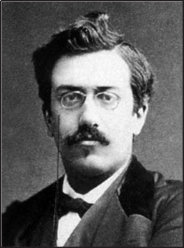- RABUT
- FRANCE (see also List of Individuals)\
 16.2.1852 Paris/F - 31.3.1925 Paris/F\Charles Rabut graduated from Ecole des Ponts et Chaussées in 1874 after having gone through Ecole Polytechnique. From 1884 he was a collaborator of the Eastern French railways which had suffered from various losses in civil engineering structures often due to material damages and a poor design that was by then not yet realized. Rabut developed to a specialist in finding the exact causes of failure, then a redesign and adding its monitoring for a certain period. This threefold procedure had become a standard for all modern structures. Rabut was appointed professor at Ecole des Ponts et Chaussées in 1896, where he lectured in construction materials and appears to have had the first lecture in concrete structures by 1900. Rabut was appointed Inspecteur Général of the French Bridges and Roads Corps in 1912. He was awarded the Prize of its journal in 1897 and the 1920 Prix Rouville for his significant contributions to the art of engineering. In 1915 he was awarded Prix Poncelet from Académie des Sciences and was elected its Member in applied sciences in 1924.\Rabut mainly contributed to two problems: (1) Pure mathematics where he proposed transformations and their invariants as well as methods to solve systems of various unknowns, and (2) Applied mechanics related to engineering works. In the latter works he investigated the stability of bridges and their foundation principles, as a reformer of the then current design practice. Whereas traditional construction was mainly based on stones, engineers realized the advents of concrete, and there was a small way to introduce reinforced material of construction to profit from both the structural resistance of that currently standard construction material under both pressure and tension. Rabut in addition contributed to hydraulics by introducing a hydraulics laboratory at the Ecole where he also had a course in hydraulic engineering. As others, he was pursued of the large merits that would be derived from hydraulic modeling in questions impossible to treat by a mathematical approach.\Boucheny, G. (1926). Rabut, Charles. Revue Encyclopédique Universelle 6: 713-714. PCoronio, G. (1997). Charles Rabut. 250 ans de l'Ecole des Ponts en cent portraits: 154-155.Presses de l'Ecole Nationale des Ponts et Chaussées: Paris. P Hager, W.H. (2003). Charles Rabut. Cimetière Montparnasse: Paris. P Rabut, C. (1918). L'évolution scientifique de l'art de bâtir. Doin: Paris.Rabut, C. (1923). Influence de Bazin dans l'enseignement de l'hydraulique. Annales des Ponts et Chaussées 93(1/2): 65-73.
16.2.1852 Paris/F - 31.3.1925 Paris/F\Charles Rabut graduated from Ecole des Ponts et Chaussées in 1874 after having gone through Ecole Polytechnique. From 1884 he was a collaborator of the Eastern French railways which had suffered from various losses in civil engineering structures often due to material damages and a poor design that was by then not yet realized. Rabut developed to a specialist in finding the exact causes of failure, then a redesign and adding its monitoring for a certain period. This threefold procedure had become a standard for all modern structures. Rabut was appointed professor at Ecole des Ponts et Chaussées in 1896, where he lectured in construction materials and appears to have had the first lecture in concrete structures by 1900. Rabut was appointed Inspecteur Général of the French Bridges and Roads Corps in 1912. He was awarded the Prize of its journal in 1897 and the 1920 Prix Rouville for his significant contributions to the art of engineering. In 1915 he was awarded Prix Poncelet from Académie des Sciences and was elected its Member in applied sciences in 1924.\Rabut mainly contributed to two problems: (1) Pure mathematics where he proposed transformations and their invariants as well as methods to solve systems of various unknowns, and (2) Applied mechanics related to engineering works. In the latter works he investigated the stability of bridges and their foundation principles, as a reformer of the then current design practice. Whereas traditional construction was mainly based on stones, engineers realized the advents of concrete, and there was a small way to introduce reinforced material of construction to profit from both the structural resistance of that currently standard construction material under both pressure and tension. Rabut in addition contributed to hydraulics by introducing a hydraulics laboratory at the Ecole where he also had a course in hydraulic engineering. As others, he was pursued of the large merits that would be derived from hydraulic modeling in questions impossible to treat by a mathematical approach.\Boucheny, G. (1926). Rabut, Charles. Revue Encyclopédique Universelle 6: 713-714. PCoronio, G. (1997). Charles Rabut. 250 ans de l'Ecole des Ponts en cent portraits: 154-155.Presses de l'Ecole Nationale des Ponts et Chaussées: Paris. P Hager, W.H. (2003). Charles Rabut. Cimetière Montparnasse: Paris. P Rabut, C. (1918). L'évolution scientifique de l'art de bâtir. Doin: Paris.Rabut, C. (1923). Influence de Bazin dans l'enseignement de l'hydraulique. Annales des Ponts et Chaussées 93(1/2): 65-73.
Hydraulicians in Europe 1800-2000 . 2013.
